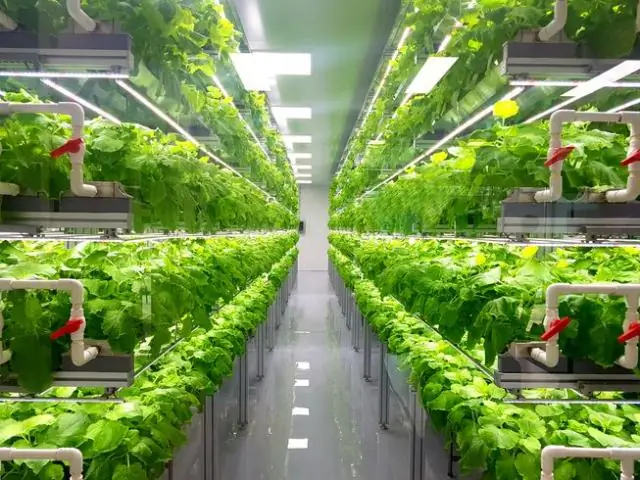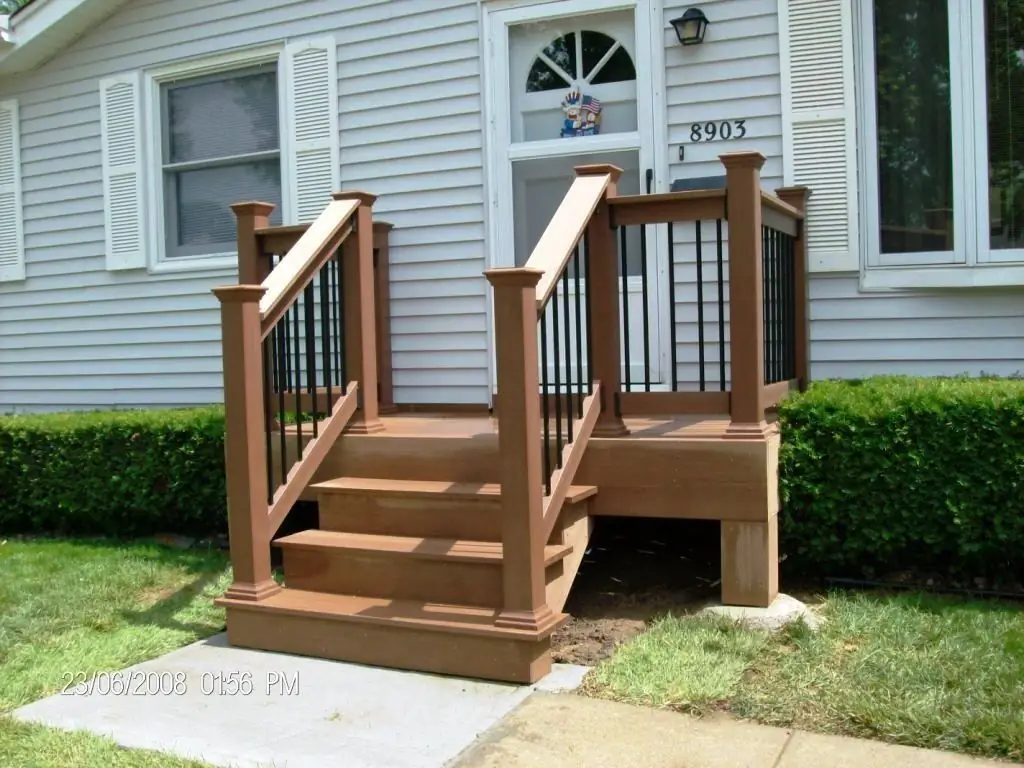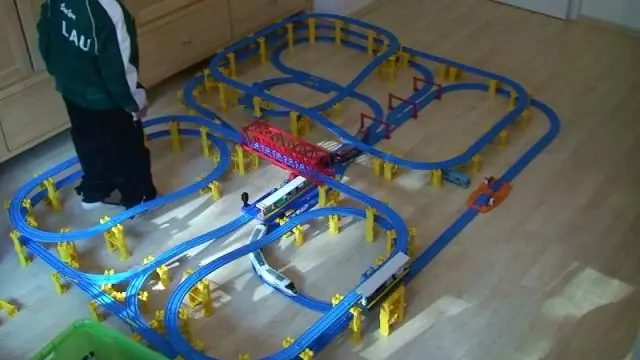
Table of contents:
- Author Bailey Albertson [email protected].
- Public 2024-01-17 22:26.
- Last modified 2025-06-01 07:32.
Making a glass greenhouse with your own hands

Today it is difficult to find a site where there is no self-made greenhouse - the pride of the owner of the dacha. The main issue associated with the construction of a greenhouse building is the correct choice of material and manufacturing technology. A classic of the genre is a greenhouse made of traditionally used glass, which has a number of advantages compared to polycarbonate, film and other materials. You can build a reliable and durable glass greenhouse that will delight the summer resident with an abundant harvest of vegetables, herbs and flowers with your own hands.
Content
-
1 Glass as a material for a greenhouse - pros and cons
1.1 Comparison of glass and polycarbonate greenhouses
-
2 Preparation for construction
- 2.1 Location determination
-
2.2 Project selection: dimensions and drawings
2.2.1 Photo gallery: sketches and drawings of glass greenhouses with your own hands
- 3 Recommendations for the selection of glass
-
4 Preparation of materials and tools
- 4.1 Calculation of material requirements
- 4.2 Required tools
-
5 Step-by-step instructions for building a glass greenhouse with your own hands
- 5.1 Video: Assembling the greenhouse timber frame
- 5.2 Video: greenhouse glazing
-
6 Tips for finishing and decorating
- 6.1 Photo gallery: options for glass greenhouses
- 6.2 Video: DIY glass greenhouse production
Glass as a material for a greenhouse - pros and cons
The use of glass for the construction of wooden or metal greenhouses allows you to maintain a favorable microclimate in a capital building, which allows you to please the summer resident with a large harvest several times per season
Glass greenhouses are a classic version of a greenhouse structure.

The walls and roof of a classic greenhouse are covered with glass
Glass has several advantages:
-
it is used all year round for a long period with the preservation of transparency, structure and appearance;

Winter greenhouse Plants can be grown in a heated glass greenhouse even in winter
-
transmits well the light necessary for active plant growth;

Inside a glass greenhouse Favorable conditions allow plants to develop quickly
- provides a high degree of thermal insulation of the greenhouse premises;
- easy to clean and resistant to abrasion;
- quickly replaced when damaged, including inexpensive, used glass;
- does not emit harmful substances and odors during heating and cooling, as it is an environmentally friendly material;
- resistant to chemicals used for cleaning;
- in a reinforced or tempered form (thermal glass) is capable of withstanding the adverse effects of large hail.
In addition, glass greenhouses stand out for their attractive appearance that lasts for decades.
Along with a complex of advantages, a greenhouse structure made of glass has weaknesses:
-
needs a reliable frame and a solid foundation, which is associated with the increased mass of glass. For example, the weight of a square meter of glass with a thickness of 4 millimeters is 10 kilograms, and when using six-millimeter glass, the mass increases by one and a half times;

Greenhouse on a foundation The strip foundation can withstand the weight of the heavy metal frame and glazing
- requires increased costs during construction, associated with the use of an expensive glass coating and the construction of a foundation;
- susceptible to mechanical stress and shock loads;
- heats up quickly and cools sharply when the daily temperature changes, which is associated with the high thermal conductivity of the glass;
- erected only in the form of a house. Greenhouse design options are limited. This is due to the characteristics of the material used for the coating.
Comparison of glass and polycarbonate greenhouses
For the manufacture of greenhouses, polycarbonate is also used - a polymer plastic that can have several layers with internal bridges to ensure rigidity.
The use of polycarbonate for covering greenhouses, which has an air gap between the layers of material, provides high thermal insulation of the greenhouse.

Polycarbonate can have different thicknesses and the number of air spaces
This contributes to the maintenance of a favorable microclimate with temperature extremes. For this indicator, polycarbonate structures are superior to glass greenhouses, in which sudden changes in daily temperature can be observed.
Polycarbonate greenhouses are shock-resistant and low-maintenance. Using flexible polycarbonate, it is possible to build greenhouses with a radius roof and an original design.

Polycarbonate greenhouse is different in design
However, the layered structure of polycarbonate and the need for a special accurate fixation of the coating makes it difficult to independently install greenhouses with a polycarbonate coating. The process of building a polycarbonate greenhouse is quite laborious and is carried out by professionals.
In addition, in winter, under the mass of snow cover, polycarbonate sags and may burst. In this case, replacing the polycarbonate cover of the greenhouse will require serious financial investments.

Heavy snow cover can destroy a polycarbonate greenhouse
The thermal insulation characteristics of the material allow the use of polycarbonate for winter greenhouses equipped with heating. Given the increased cost of the material, it is impractical to use polycarbonate for summer unheated greenhouses. Unlike polycarbonate, glass greenhouses can be operated all year round, if internal heating of the room is provided in winter.
Each individually decides which material to give preference to. However, despite the shortcomings, many summer residents prefer glass greenhouses, which have many advantages over greenhouses made of other materials, including polycarbonate.
Preparation for construction
At the preparatory stage, it is important to choose the right place for the future construction, determine the size of the greenhouse and prepare a drawing
Location determination
When choosing a place to build a future greenhouse, pay attention to the following points:
- lighting level of the site. The greenhouse should not be shaded by trees or objects on the site;
-
the orientation of the greenhouse building. To ensure uniform heating of the room, it is advisable to correctly orient the building;

Greenhouse orientation It is important to ensure maximum illumination
- the direction of the winds. It is advisable to protect the colder side wall of the greenhouse, located on the leeward side, with shrubs;
- features of the soil and topography of the site. A flat and dry place is suitable for installing a greenhouse;
- distance to sources of electrical supply and water supply. Their close location is convenient for organizing room heating and watering plants.
Improper positioning of the greenhouse can cause its destruction and slow down the development of plants.

Pay attention to where the greenhouse cannot be placed
Project selection: dimensions and drawings
To facilitate the process of building a greenhouse, it is necessary to develop a drawing of the structure

The drawing shows all dimensions
For a small summer cottage, the size of the greenhouse can be:
- length 4-6 meters;
- width 2-3 meters;
- height 1.8-2 meters.
With large sizes of the suburban area, you can build a greenhouse of increased dimensions.
At this stage, you need to choose the shape of the greenhouse. The use of glass that does not deform limits the choice of design solutions. You can give preference to a rectangular room or a greenhouse with a multifaceted base.

The shape of the greenhouse is selected depending on the needs
The roof of the greenhouse can be pitched, gable, or pyramid-shaped. The number of roof edges can exceed 4.
Remember that by giving preference to a wall greenhouse structure, you can rationally use the free area on the site and spend less effort on construction and heating.

With a small area of the site, you can place a greenhouse next to the building
You can use a typical project and put down the required dimensions on it. This will facilitate the design work of the greenhouse structure

It is convenient to use a typical drawing, on which you can enter your dimensions
Considering the increased weight of glass packages, the building needs a reliable foundation with a height of 0.4-0.5 m and a solid frame. A foundation made of concrete blocks or a monolithic strip base can provide stability to the structure.

Belt-type foundation - the best solution for a greenhouse
For the frame of the greenhouse, you can use a wooden beam at least 5x5 cm in size or a metal profile. The distance between the vertically arranged posts can be 0.6-0.8 m, depending on the dimensions of the glass, old wooden windows or double-glazed windows, and the dimensions of the frame.
Pay attention to ensuring the angle of inclination of the roof is greater than 15 °. This is necessary so that precipitation does not linger on the glass surface of the structure.
Photo gallery: sketches and drawings of glass greenhouses with your own hands
-

Greenhouse 2.5x1.9 - Such a greenhouse is suitable for a small area.
-

Single-slope greenhouse 2,5х3,5 - The greenhouse can be installed next to the building
-

Greenhouse 5x2.4 - Metal frame construction
-

Recessed greenhouse - The original greenhouse buried in the soil
-

Greenhouse 5.4х3.6 - Greenhouse with timber frame
Glass selection recommendations
To cover the greenhouse, you can use various types of glass, the dimensions of which must correspond to the dimensions of the frame:
- single (2.5 mm thick). The material is quite fragile. It can be used for greenhouse side walls in wooden frames, the maximum size of which does not exceed 50-60 cm;
- double (3-3.5 mm thick). Insufficient strength of glass does not allow using it for upper windows;
- display case with a thickness of more than 6 mm. The material has high strength, requires reliable fastening and strong supports;
- multilayer. It consists of outer glass layers and a plastic spacer. The material has a high price, is resistant to impacts, is safe, since the fragments are held by a plastic gasket;
- hardened. Its strength is 4 times higher than that of ordinary glass. However, upon impact, it crumbles into the smallest fragments, which cannot cause injury. Collecting such small fragments of glass from the garden is problematic.
The thickness of the glass, depending on the distance between the supports and the brand, can be 2-6 and more millimeters.

Glass strength increases with increasing thickness
For the top panels and walls of the greenhouse, multilayer triplex can be used. This, of course, will affect the cost of glazing, but will avoid problems with carelessly broken glass and the collection of small fragments. The wide range offered by manufacturers allows the use of glass with heat-reflecting or heat-absorbing properties. These glasses have a special thin coating that reduces heat loss and enhances the glazing.
The choice of glass for the greenhouse must be made taking into account its purpose. For example, for a room with tropical plants, multi-layer glazing is suitable, which reduces heating costs. For growing herbs and vegetables, ordinary glass or old glazed window frames are suitable.
The use of double-glazed windows will entail additional costs, but will create more favorable conditions for the growth and development of plants. The following types of glass bags are used for glazing greenhouses:
- single-chamber. They have an air gap between two glass sheets, which provides sound insulation and thermal protection. Low weight and reasonable price allows using single-chamber bags for glass roofs and walls of small greenhouses;
- two-chamber. They differ from single-chamber ones in the increased number of glass sheets and interlayers, significantly reduce heat loss. However, they are heavy. They can be used to insulate the greenhouse wall from the north side;
- heat-saving. The space between the sheets of glass is filled with an inert gas, which reduces the thermal conductivity of the structure;
- energy saving. A thin coating is applied to the glass surface of the package, which unilaterally transmits solar heat and light rays.
Preparation of materials and tools
Calculation of the need for materials
To determine the required amount of materials, it is necessary to perform calculations using the drawing

Dimensioned drawing allows you to calculate the amount of required materials
To build a small glass greenhouse with a wooden frame, shown in the drawing, you will need:
- support corners 45x45 mm (14 pcs. 1.5 m each) - 21 m;
- wooden beams 250x100 mm (2 pcs. 6 m and 2 pcs. 3 m) - 18 m;
- bars 100x100 mm for the bottom strapping (2 pcs. 6 m and 2 pcs. 3 m each) - 18 m;
- bars 100x60 mm for racks (14 pcs. 1.6 m each) and struts (8 pcs. 1.9 m each) - 37.6 m;
- bars 100x60 mm for the top strapping (2 pcs. 6 m and 4 pcs. 1 m each) - 16 m;
- bars 100x60 mm for a door jamb (2 pcs. 1.95 m each and 1 pc. 1.1 m long) - 5 m;
- slats 100x30 mm for rafters - 34 m;
- boards for the door frame 60x20 mm - 6 m;
- beams 50x50 mm for connecting the rafter structure (3 pcs. 6 m each) - 18 m;
- hardware (nails, screws and screws);
- polyurethane foam;
- glass 4 mm thick (new or used) - 55 m 2;
- sealant, liquid nails and putty for fixing and sealing glazing;
- hinges, handle and door lock;
- corners for fastening wooden parts.
Summing up the length of individual beams with a section of 100x100 mm, we get the need for this material - 76.6 m (18 + 37.6 + 16 + 5).
To increase the stability of the building being built, it is advisable to prepare a strip foundation. Given the depth of the strip foundation (0.4 m), the width of the tape (0.2 m) and the perimeter of the greenhouse (18 m), we can calculate the volume of the poured concrete - 0.4 mx0.2 mx18 m = 1.44 m 3.
The following materials will be required:
- river or quarry sand;
- medium-fraction crushed stone;
- Portland cement grade M300 and above;
- roofing material, which spreads between the beams of the base and the foundation;
- anchoring elements for fastening the frame to the foundation - 4 pcs.
In addition, water is required to prepare the solution.
Required tools
The following tools and equipment are required to mark and prepare the strip base:
- cord and pegs;
- container for preparation of concrete mixture or concrete mixer;
- shovels and buckets;
- Master OK.
For further work on assembling the greenhouse, it is necessary to prepare:
- hacksaw;
- electric planer;
- a hammer;
- chisels;
- screwdriver;
- glass cutter;
- building level.
DIY step-by-step instructions for building a glass greenhouse
Using the example of a glass greenhouse, assembled on the basis of a wooden frame, consider the sequence of operations.
Build according to the following algorithm:
- Prepare the greenhouse site: plan the soil, remove vegetation.
-
Use pegs and a cord to mark out the trench for the strip foundation.

Base marking Marking makes work easier
- Dig a trench 0.4 meters deep and 0 2 meters wide.
- Plan the bottom of the pit and pour 10 cm of crushed stone-sand mixture.
- Assemble the formwork from boards or wood-based panels, checking the verticality of the edge using a building level.
- Lay welded mesh or steel reinforcement, fix the frame anchors.
- Prepare concrete by mixing cement with sand in a 1: 3 ratio, add crushed stone and water.
-
Pour the concrete solution, let it harden.

Poured foundation Such a base will provide stability for a heavy greenhouse.
- Lay two layers of roofing material on the foundation surface to protect the timber frame from moisture.
-
Treat wood blanks with an antiseptic compound that prevents the development of fungus.

Wood processing With a sprayer, you can quickly perform antiseptic treatment of support bars
- Screw the supporting rails of the frame to the anchors.
-
Prepare the bars for attaching the glass by making the appropriate samples in them.

Processing of bars Using an electric planer, you can quickly make a sample for installing glass
-
Fasten the vertical posts, attach the top harness bars to them.

Fastening upright posts To ensure the rigidity of the structure, corners are installed
- Check the verticality of the structure.
- Install braces, fix the elements with metal corners.
-
Assemble the roof frame using rafters and beams, hang the doors.

Assembled frame The frame is assembled directly at the installation site
-
Cut the glasses to the required size.

Glass cutting It is necessary to hold the glass while working with a glass cutter
- Install glazing elements into the grooves of the beams, use a sealant, putty or liquid nails.
- Lubricate with sealant and secure the glazing beads.
- Check that there are no gaps, if necessary fill the gaps with polyurethane foam.
Video: assembling a greenhouse wooden frame
Video: greenhouse glazing
Tips for decoration and decoration
With a creative approach, an ordinary greenhouse can please not only the grown crop, but also become the "highlight" of the suburban area

Natural stone finishing, perimeter path and flowerpots with plants immediately attract attention
Every greenhouse owner wants it to please the eye and harmoniously fit into the design of the site.
When thinking about finishing and decorating a greenhouse, you can use the following recommendations:
-
paint the frame with oil paint. This is a budget solution that does not require significant costs;

Painted greenhouse Painting the timber frame will improve the presentation of the greenhouse and protect the wood
-
cover wooden elements with colored varnish. You can use a stain for toning, which gives the wood original shades;

Wooden greenhouse Wood varnishing improves the presentation of the greenhouse
-
finish the base from the outside. External finishing with tiles, stone, decorative materials should be combined with the finishing of the building;

Greenhouse with plinth The decorative finish of the basement gives the structure solidity
-
make original drawings on the glazing or paint the basement.

Greenhouse drawing This drawing is easy to do on your own.
You can also improve the area adjacent to the greenhouse: make stone paths, flower beds, flower beds, plant ornamental shrubs and plants.

A stone path and a flower bed with plants successfully fit the greenhouse into the exterior of the site
There are many landscaping options. The main thing is to show your imagination!
Photo gallery: glass greenhouse options
-

Greenhouse with double-glazed windows - Multi-layer glazing reliably retains heat
-

Small greenhouse - Such a structure is suitable for a small area.
-

Single slope greenhouse - Economical option for giving
-

Greenhouse extension option - Greenhouse blends harmoniously with home design
-

Glass greenhouse - Double-glazed windows inserted along the edges facilitate ventilation
-

Budget greenhouse - Used for the construction of window frames
-

Greenhouse - Option of a light greenhouse from an aluminum profile
-

Prefabricated metal greenhouse - The structure has a non-standard shape
-

Wooden greenhouse - Environmentally friendly wood is used for the frame
-

Dome roof greenhouse - The shape of the structure allows you to comfortably move inside
-

Standard greenhouse made of metal profiles - Such greenhouses are found in many areas.
-

Greenhouse tent - The inside of the greenhouse is spacious enough
Video: DIY glass greenhouse production
It is not difficult to make your own greenhouse, guided by the recommendations given. It is important to use high-quality materials, choose the right glass, take seriously the choice of the design of the greenhouse and the development of the drawing. This will make it possible to build a solid structure that will bring pleasure and delight with a rich harvest for decades.
Recommended:
How To Build A Wooden Porch With Your Own Hands: In Stages, Photos And Videos

Detailed description of the construction of a wooden porch. Materials used, work procedure step by step
How To Make A Bar Stool With Your Own Hands From Wood, Metal And Other Materials + Drawings, Photos And Videos

Bar stools manufacturing options. Required tools, materials used. Step-by-step description of the manufacturing process with a photo
How To Make A Veranda With Your Own Hands To The House - Instructions, Projects, Drawings, Photos And Videos

The article describes how to build a veranda close to the house with your own hands
How To Choose And Build A Foundation For A Bath With Your Own Hands - 4x6, 3x4 And Other Sizes, Tips, Instructions, Photos And Videos

How to make a foundation for a bath with your own hands. Types and features of foundations. The choice of materials and technology, installation rules and step-by-step instructions
How To Build A Warm Chicken Coop For The Winter With Your Own Hands - Instructions With Photos And Videos

The need to insulate the chicken coop. What material can be used. How to make a winter poultry house yourself: step by step instructions. Treatment and care
